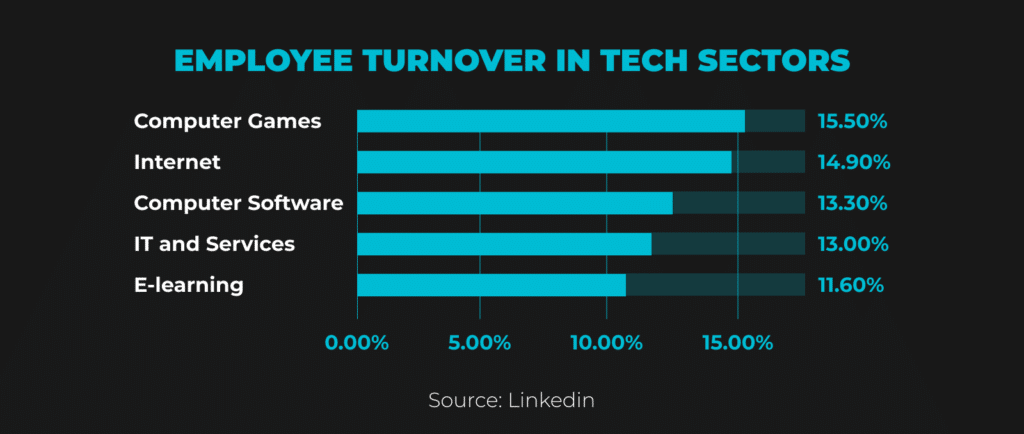A Look at Tech Staff Turnover and How to Reduce It
For any business owner, an employee’s sudden or premature departure has overarching implications. According to researchers from Gallup, American businesses lose up to $1 trillion due to staff turnover.

In more relatable terms, when an employee voluntarily chooses to leave, it could lead to costs equivalent to almost double their yearly compensation package! This is not to mention the indirect costs of employee turnover, such as intellectual property loss and exposure to endless litigations.
Moreover, the departure of a team member reverberates beyond financial repercussions. It affects the remaining staff’s morale, team spirit, and relational dynamics. The ramifications are always more than just a profit and loss scenario.
In this article, we delve deeper into staff turnover meaning, its causes, and how to calculate it in your organization. We also highlight top strategies for reducing turnover cases in IT-driven businesses. Keep reading to stay updated.
What is Staff Turnover and How to Calculate It
Staff turnover rate is the percentage of employees who leave a company within a given timeframe, in most cases quarterly or annually. Employee turnover rate matters to many business owners because it is a crucial metric that offers insights into the performance of an organization’s HR processes and resources.
A higher turnover rate means staff members leave simultaneously, which can result in many bottlenecks, if not a crisis. For instance, you might experience an acute shortage of skilled or specialized personnel, leading to unbudgeted expenses for recruiting replacements.
There are two prevalent types of staff turnover, including voluntary and involuntary. In the first case, the staff member leaves the company voluntarily. Similarly, the staff member can be required to leave, resulting in involuntary turnover. Business leaders need to get an accurate grasp of the overall turnover rate.
That said, here is how to calculate staff turnover in IT companies in three steps:
Step 1: Gather the Necessary Information
Start by gathering the necessary information required to calculate the overall turnover rate. This includes the number of staff members your organization had at the beginning of the year, the number of employees retained at the end of the year, and the number of those who left during the same period.
Step 2: Add the Average Number of Staff Members
After that, calculate the average number of employees your company has. You can do this by adding the number of staff members at the beginning of the year to the number of employees retained at the end of the same period and dividing the answer by two.
So, if you had 100 employees at the beginning and ended up with 80, the average number of staff members would be (100 + 80) / 2.
This will give you an average of 90 employees.
Step 3: Compute the Turnover Rate Percentage
Next, divide the number representing those who left the company during the year by the average number of staff members before multiplying it by 100. This will give you the employee turnover rate expressed as a percentage.
Here is the formula:
Employee turnover rate = (number of employees who left ÷ average number of employees) × 100.
So, assuming 20 employees left the company, and using the value we got in the second step, the annual employee turnover rate would be (20 ÷ 90) × 100. This gives you 22.22%.
Why Specialists Leave
Although many employees dream of staying in an organization and witnessing it grow from scratch to unprecedented heights, this often doesn’t turn out to be the case. For tech specialists, here are the reasons that may prompt them to leave a company sooner than they anticipated:
Lack of Growth Opportunities
McKinsey & Company estimates that 41% of tech professionals cite a need for growth opportunities as the main reason why they switch jobs often. In other words, these professionals have an appetite for learning and developing new skills and won’t hesitate to revamp their CVs for a new job hunt if the current position seems stagnant.
Insufficient Compensation & Benefits
Value-based compensation and benefits are a deal-breaker for all employees, not just tech professionals. It should be more competitive than other potential employees. If not, the employees might cite unfairness and buy time while looking for a job that pays better. They might even quit with a simple email notice.
Poor Communication
Trusted insights reveal that 70% of corporate problems, including staff turnover, emanate from poor communication. When the management skips critical meetings or fails to organize them in the first place, employees are uninformed and undervalued. And in pursuit of recognition, they may choose to switch employers.
Toxic Culture and Work Environment
A highly toxic company culture or working environment may affect employees in many ways. For instance, it can lead to conflicts, mistrust, and misunderstandings. Ultimately, those who don’t have a thick skin to sojourn might leave without thinking twice, even if it means staying out of employment for a while.
Limited Creativity and Innovation Opportunities
Tech professionals are inherently problem solvers. They expect you to motivate and encourage them to push their creative intuition to the limit. If this is missing, it will affect their morale and productivity, and they’ll likely leave.
Lack of Purpose and Alignment
Another reason tech employees leave some companies is a need for more purpose and alignment, especially if they feel side-lined from the company’s progress and plans. In the long haul, this erodes their trust in the company and its management gradually and invokes an undervalued feeling. Unless the issue is addressed early enough, they’ll start hunting for a new job and eventually leave.
Doubts About Job Security
If there are unclearly defined roles and inconsistent feedback from the employer, developers may start to doubt the job’s stability and eventually churn. And with the sudden layoffs across many industries, IT professionals prefer getting ahead of the curve by seeking jobs in companies that guarantee long-term employment and more opportunities for professional development.

How to Reduce Staff Turnover Rates
If an integral team member leaves your company today, you’ll likely not only face productivity risk; clients who had developed relationships with the employee may also leave. You would want to reduce staff turnover before it even manifests to avoid such a situation. Here are some tips:
Start By Hiring and Retaining High-quality Employees
Your first step toward mitigating a possible high staff turnover in the future involves hiring high-quality candidates with long-term retention in mind. This means avoiding tech professionals who are more likely to job-hop and switch fields.
Even better, you can test a candidate’s resilience by asking questions regarding past roles. For instance, ask why they left their former job and evaluate the answer to see the rationale. A candidate who cites something vague is likely dishonest and hiding something that makes them a high-risk turnover employee.
Enhance the Onboarding Experience
It has been proved statistically that employees who plan to leave an organization will likely do so within the first 45 days. This points out that staff members may begin to feel a disconnection from the employer right from the onboarding phase.
With this in mind, it will help if you adopt a seamless onboarding process that makes job candidates feel at ease from the word start. For instance, on top of taking them through a clear onboarding schedule, immerse them in tasks and encourage productive engagements to avoid bottled-up concerns.
Support a Healthy Work-life Balance
According to a recent study, 74% of tech talents in the US prefer to work remotely, a figure that embodies the desire of most of their colleagues in other global job markets. While this working style benefits both the company and the employee in several ways, it also poses a risk regarding work-life balance.
Ensure that your work schedule is within business hours or a mutually agreed upon time to grant the remote employees enough time to spend on other life issues. You can also support mental health awareness by facilitating monthly or quarterly allowance for therapy and counseling services.
Clarify Opportunities for Pay Rise
Something familiar that you noticed among employees is that most of them are hopeful of a pay rise when the company grows. Extend the courtesy of letting them know that nothing is set-in-stone. That said, take time to sit down with individual employees and share each other’s concerns, goals, and ambitions. Then, seize the opportunity to explain the grand plan that you have for them in terms of performance management or competitive compensation & benefits.
How Newxel Can Help with Solving This Issue
What if we told you that you could stop worrying about employee turnover and delegate the risk to a third party as you focus on discharging business leadership roles? Enter the world of staff augmentation, where a full-service company, such as Newxel, builds a tech team for your business and fine-tunes it to match your needs in terms of goals and retention.
Our staff augmentation services extend to hiring value-matched candidates only and harnessing all the latest practices to raise the average retention rate to 94%. Further, we maintain cohesive teams through various initiatives, such as team-building activities with the client in attendance. This allows you to bond with your team and get to know its members at a personal level, creating a positive synergy that will ward off employee turnover.
Additionally, IT staff augmentation companies usually offer all these services at a relatively affordable monthly fee. This helps you stay within budget and get enough to reinvest in your team’s professional development, ultimately lowering turnover risks.
Conclusion
A high staff turnover rate can expose your business to more than financial risks. It takes a toll on general productivity and morale. Or, even worse, it can bring a ripple effect, followed by a mass exodus of employees from your company. One way of avoiding this without straining in terms of salary budget is through IT staff augmentation.
Contact us today to get started with this model and let our experts worry about the turnover rate.






